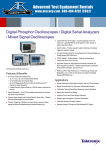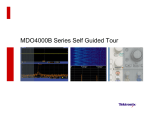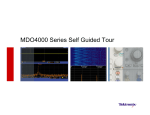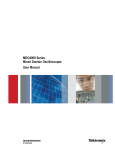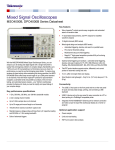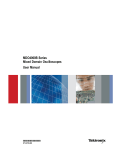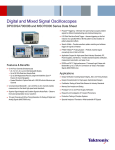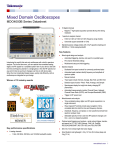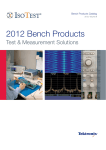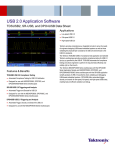Download FEE 131016 Critical Considerations for Probing
Transcript
Critical Considerations for Probing Agenda Types of Probes Probe Selection Criteria How Probes Affect Your Measurement Choosing a Probe 2 Critical Considerations for Probing Types of Probes Probes: Critical Elements of the Measurement System 4 Critical Considerations for Probing Basic Probe Types Current Voltage Logic Passive Passive Active Optical Passive Active Active Z0 High Z Differential High Voltage SingleDifferential Ended 5 Critical Considerations for Probing AC DC AC Passive Voltage Probes Most basic probe with no active components Available in 1X, 2X, 10X, 100X and switchable Advantages – – – – Inexpensive Mechanically Rugged Wide Dynamic Range High Input R Disadvantages – High Input C – Inductance of long ground lead Tektronix P2220 Probe 1/10X, 200 MHz Tip Cable LGround Lead Probe 6 Critical Considerations for Probing Active Voltage Probe Uses active components Advantages – – – – Low Input C Wide Bandwidth High Input R Better Signal Fidelity Disadvantages – Higher Cost – Limited Dynamic Range – Mechanically Less Rugged LGround Lead 7 Critical Considerations for Probing Probe Tektronix TAP1500 Active Voltage Probe 10X, 1.5 GHz Differential Active Voltage Probes Differential Probes measure signals that are referenced to each other instead of earth ground. Advantages – – – – Wide bandwidth Large Common Mode Rejection Ratio (CMRR) Minimal skew between inputs Small input capacitance Input 1 + _ Input 2 Probe 8 Critical Considerations for Probing VOUT Scope Channel Amplifier Scope Tektronix TDP0500 and TDP1000 Differential Probe 500 MHz or 1 GHz, 42V Current Probes Measures the electromagnetic flux field around a conductor to determine the current flow Two Major Types: – AC current probes (passive) – AD/DC current probes (active) Features to Consider: – Automatic scaling and units – Split-core vs. fixed-core connection to the device Tektronix TCP0150 AC/DC Current Probe 150 A, DC to 20 MHz 9 Critical Considerations for Probing Logic Probes The MSO4000B Series Oscilloscope offers 16 digital channels Recommend the P6616 digital probe: 10 – 16 Channels, 2 Groups of (8) channels – First coax in each group is colored blue for easy identification – Standard automotive spade connection for the common ground – 3 pF loading Critical Considerations for Probing Tektronix P6616 iCapture™ - One Connection for Analog and Digital iCapture™ (Analog Mux) – – Acquire digital channels with digital time resolution (80ps) Simultaneously route any (4) digital channels to analog channels – Validate signal connection – Check signal integrity – Validate logic threshold – Improve timing resolution Digital Channels + - C A0 Analog Channels D0 Analog Mux + + - Critical Considerations for Probing Digital 2.5 GHz Analog Full Bandwidth Analog Probe Selection Criteria What is Your Probe Selection Process? The first one you spot in a drawer Distract a co-worker and take theirs 13 Critical Considerations for Probing What is Your Probe Selection Process? Original signal Signal at probe tip is changed Signal at the oscilloscope Signal display with DSP correction Deliver a Signal to the Scope with Good Fidelity 14 Critical Considerations for Probing The Ideal Probe Absolute Signal Fidelity Rin = ∞ Cin = 0 CABLE No affect on the original signal Easy to connect No affect on the original signal – No signal source loading! – Zero Input Capacitance – Infinite Input Resistance Absolute Signal Fidelity – – – – Unlimited bandwidth “zero to infinity” Unlimited rise time “instant – 0 s” Zero attenuation “one-to-one” Linear phase across all frequencies A convenient and easy way to connect to the device-under-test – Mechanically well suited to application 15 Critical Considerations for Probing The Measurement System (Scope and Probe) No easy formula to calculate Measurement System specifications Tektronix provides specifications for scope & probe combinations For best results, use the probes recommended for your scope 16 Critical Considerations for Probing I2C (Physical Part) +V Pull-up resistors SDA SCL Master Critical Considerations for Probing Device 3 Device 4 CAN is a differential BUS CAN High Speed Differential Bus Signal Tx Rx CAN_H CAN Controller Rx CAN_L CAN Physical Layer Tx dominant Electronic Control Unit CAN-H 3.5V 1 2.5V 0 1 1.5V CAN-L recessive Tx + + - - Critical Considerations for Probing path + + - - Rcv recessive Differential & Floating Measurements A differential measurement is the difference in voltage levels between two input signals. For a floating measurement, neither input is at ground potential. Differential Measurement V1 Unit Under Test VMeas Floating Measurement Unit Under Test VMeas V2 V1 Earth Ground V1 = Single-ended Measurement V2 = Single-ended Measurement VMEAS = V1 + Inverse (V2) 19 Critical Considerations for Probing V1 Earth Ground VMeas = Measured Voltage between 2 probed points V1 = Offset Voltage above true ground Differential Measurements with Single-ended Probes Poor CMRR – Inaccurate measurement (combination of offset and gain) – Noisier measurement Skew – Amplitude and timing errors V1 Skew VMeas = V1 + [ Inv (V2) + CMRR or Skew] V2 20 Different Offset or gain Critical Considerations for Probing Deskew is a Source of Error Deskew is important when measuring: – Pseudo-differential (CH1 + (Inv (CH2)) – Timing/Propagation Delay Include Probe adapters in deskew adjustment If possible, use the same probe family Deskew Fixture Deskew 7.40 ns 21 Critical Considerations for Probing Result of “Floating” Measurements with Ground Connection 22 Critical Considerations for Probing How Probes Affect Your Measurement Critical Considerations for Probing Probes Will Affect Your Measurement Signal Source Loading – Measurement system’s impedance is critical – Input Resistance – Input Capacitance – Inductance Signal Fidelity – Measurement system parameters also crucial – Bandwidth – Rise Time Good Signal Fidelity CABLE Minimize affect on the original signal Easy to connect 24 Critical Considerations for Probing Signal Source Loading When the probe is connected to the DUT, the probe will draw some current. The impedance values of the probe and scope will affect the measured signal. The Measurement System impedance (Z) consists of: – Resistive Elements (Resistance, R) – Reactive Elements (Capacitance, C and Inductance, L) which vary over frequency Good probe design uses R, L, and C elements to influence signal fidelity, attenuation, and source loading over specified frequency ranges. Z Z Device Under Test (DUT) 25 Critical Considerations for Probing Test Point Z Measurement System (Probe and Scope) Source Loading – Input Resistance Rin acts like a voltage divider Higher input resistance – less loading Lower source resistance – less loading DUT Rsource Probe Probe Tip RIn Esource LGround Lead 100% 90% 100% 90% 10% 0% 10% 0% Source Signal 26 CIn Critical Considerations for Probing Decreased Signal Amplitude Rin Vmeas = Vsource Rin + Rsource Effects of Input Resistance Source Loading – Input Capacitance Smaller input capacitance - higher probe impedance, less loading As signal frequency increases, capacitance increases and loading increases DUT Rsource Probe RIn Esource CIn LGround Lead 100% 90% 100% 90% 10% 0% 10% 0% Example: Cin = 100 pF tr ~ 220 nsec Cin = 10pF tr ~ 22 nsec If Rsource = 1 kΩ Source Signal 27 •Decreased Amplitude •Phase Change •Slower Rise Time tr ~ ~ 2.2(Rsource x Cin) Probe Tip Critical Considerations for Probing Effects of Input Capacitance Source Loading - Inductance The longer the ground lead, the higher the probe inductance. Keep ground leads as short as possible to avoid ringing! Probe Tip Rsource Resonance (Ringing) RIn Esource LGround Lead 100% 90% 100% 90% 10% 0% 10% 0% Source Signal 28 CIn Critical Considerations for Probing Effects of Inductance Resonance: How Does Added Inductance Affect the Measurement? Trise of 1 ns ~ 350 MHz BW Equivalent 0.05 - 0.1 µH (combined typical) Ring Frequency Using a 1.5 pF Input Capacitance 10X High Z Active Probe and 6” Ground Lead. For a 10X Active Probe with Cin = 1.5 pF and a 6”Ground Lead = Critical Considerations for Probing 350 MHz to 500 MHz Calculating Resonant Frequency Resonant Frequency = 1 2π LC In practice, the resonant frequency should be >5 times the signal’s BW equivalent based on rise and /or fall times. This gives a guideline to the maximum inductance (or maximum allowable probe-connection loop.) Rules of Thumb: L ≈ 20 nH/inch for typical lead lengths around 0” - 3” (probe tip and ground lead) C ≈ Probe rated C plus 1 to 2 pF/inch of added lead length (probe tip) Critical Considerations for Probing Probing Tips and Tricks: Ground Lead Length Effects Coaxial Cable 3” Ground Lead 31 Critical Considerations for Probing BNC Probe Tip Adapter 1” Ground Adapter 6” Ground Lead No Ground Lead Signal Fidelity – Rise Time Insufficient rise time also affects the signal To accurately characterize your signal, follow the 1/5th Rule Tr, system < Tr,signal 5 Measured rise time depends on the signal and scope rise times Tr,Measured = (Tr,signal)2 + (Tr, system)2 Actual 32 Critical Considerations for Probing Measured Low-Capacitance Passive Voltage Probing Comparison of different probes and compensation capabilities very different results Source of error Critical Considerations for Probing Probing Tips and Tricks: Probe Adapters will Affect the Measurement Ease of connectivity and signal fidelity are a trade-off. Accessories may impact rise time and cause aberrations. Source Through 50 Ohm Terminator + 1 MOhm CH 1 TDP1000 Square Pin P6139A w/ 1” Z Lead P6139A w/ 1” Z Lead (Incorrect LF Comp) P6139A w/ Short Spring Ground 34 Critical Considerations for Probing Probe Accessories - The Connection to the DUT Connects the Probe to the DUT Adjustment tools Marker bands 9-digit part numbers are found on the web or in the User Manual Probe Tip Adapters Ground Leads (Short and Long) Attachment Klips Square Pin Adapters Solder Down Adapters 35 Critical Considerations for Probing Example Probe Loading Active Differential Probe Showing Various Adapter (e.g Square Pin Adapter) Critical Considerations for Probing Reference Signal vs. Probe Output Green = probe loading (SMA output) Blue = Probe output White = stored Reference Signal Critical Considerations for Probing Effect of Square Pin Adapter Critical Considerations for Probing Reference Signal vs. Probe + Square Pin Adapter + Pins Green = probe loading (SMA output) Blue = Probe output White = stored Reference Signal Critical Considerations for Probing Signal Fidelity – Bandwidth Limitation Complex signals contain many spectral components that cumulatively form a signal over time. – Spectral components are sine waves at varying frequencies and varying amplitudes which are added together to collectively form one signal. To accurately characterize your signal, follow the 5 Times Rule BW of system > 5 x Fundamental Frequency Fundamental (1st Harmonic) 3rd Harmonic 5th Harmonic Fourier Square Wave (1st – 5th) 40 Critical Considerations for Probing Signal Fidelity – Bandwidth Limitation 30% Amplitude error is true for a repetitive sine wave. Amplitude Actual Signal 3% 10% 20% 30% Frequency Measured Signal What if you aren’t measuring a repetitive sine wave? 41 Critical Considerations for Probing Signal Fidelity – Bandwidth Limitation Insufficient bandwidth affects the signal Amplitude – Why is the front edge affected? The front edge contains the high frequency content. – If the measurement system doesn’t have enough bandwidth, it won’t capture the high frequency portion of the signal. 3% 10% 20% 30% Frequency 42 Critical Considerations for Probing The signal delivered to the oscilloscope Insufficient BW degrades the front edge Voltage Probes: Bandwidth Limiting Filters Some voltage probes provide bandwidth limiting filters to remove unwanted high-frequency signal content. 43 Critical Considerations Considerations for for Probing Probing Critical © 2011 Tektronix 3/11 Tektronix Confidential Current Probe Degauss Removes residual magnetic flux from probe’s magnetic components High impact of measurement result (blue current waveform before and after “degaussing”) Capability of measuring DC (Hall-Element) and AC Signal Components simultaneously Critical Considerations for Probing Choosing a Probe Critical Considerations for Probing Choosing The Right Probe Carefully Consider Your Application: – – – – – – Type of signal – voltage, current, single-ended, differential… Signal frequency content (bandwidth issue) Signal rise time Source impedance (R and C) Signal amplitudes (maximum and minimum) Test point geometries Choose a probe specified for your scope! 46 Critical Considerations for Probing TekVPI® – Tektronix Versatile Probe Interface Smart communication between oscilloscope and probe – – – Automatic units displayed Nominal deskew of signal paths Probe menu on oscilloscope interacts directly with probe Provides more power to probes – – 47 Enables greater flexibility in probe combinations Enables direct connection to current probes (including ac/dc), differential probes, and singleended active probes without external amplifiers Critical Considerations for Probing TekVPI Highlights Comp box controls provides easy and convenient access to controls and indicators plus: – Enhanced gain compensation increases accuracy – Stored propagation delay speeds critical deskew procedures – Auto degauss and probe offset autozero insures repeatable measurements Advanced Remote Control is ideal for manufacturing test applications TekVPI to TekConnect Adapter Critical Considerations for Probing TekProbe to TekVPI Adapter Breakthrough in Passive Probing Mechanical Key ASIC + Probe = Perfect Match Custom ASIC inside the oscilloscope is matched to the probes Probe notifies oscilloscope what type of probe it is via TekVPI – Sets input in oscilloscope to special path (not 1MΩ or 50 Ω) Scope can optimize signal input path to remove differences in hardware – AC compensation across frequency band Mechanical keying so TPP0500 and TPP1000 cannot be plugged into an oscilloscope without the matched ASIC Critical Considerations for Probing Low-Capacitance Passive Voltage Probing Industry leading 3.9pF capacitive loading TPP1000 step response with greater bandwidth and improved flatness TPP0500: 500 MHz passive voltage probe – Standard with 350 MHz and 500 MHz models P6139A step response showing longer settling time and lower bandwidth TPP1000: 1 GHz passive voltage probe – Standard with 1 GHz and 2 GHz models Multiple ground connections included – Six inch ground lead – Short spring clip ground leads AC calibration routine optimizes frequency response Application usage – Digital system debug Half the loading with twice the bandwidth Critical Considerations for Probing Low-Capacitance Passive Voltage Probing automated Procedure frequency response adjustment High accuracy results Critical Considerations for Probing Voltage Probes Specifications Critical Considerations for Probing Differential Probe Capabilities Selectable attenuation factors Excellent CMRR capabilities Low noise floor Reduced probe loading effects Selectable bandwidth limiting filters DC Reject / AC coupling to eliminate the DC offset in the measured signal Remote access and control Versatile DUT connectivity accessories. Small Probe head Status Indicator TDP Probes Critical Considerations for Probing Differential & Floating Measurements Characteristic TMDP0200 THDP0200 THDP0100 Attenuation 25X/250X 50X/500X 100X/1000X Differential Voltage 250X: +/- 750 V 25X: +/- 75V 500X: +/- 1500 V 50X: +/- 150 V 1000X: +/- 6000 V 100X: +/- 600 V +/- 750 V +/- 1500 V +/- 6000 V 550 V CAT I 300 V CAT III 200 MHz 1000 V CAT II 600 V CAT III 200 MHz 2300 V CAT I 1000 V CAT III 100 MHz Rise Time < 1.8 ns < 1.8 ns < 3.5 ns Slew Rate < 275 V/ns @ 1/250 gain < 650 V/ns @ 1/500 gain < 2500 V/ns @ 1/1000 gain Input Impedance at the Probe Tip 5 MΩ || < 2 pF 10 MΩ || < 2 pF 40 MΩ || < 2.5 pF DC: > - 80 dB 1 MHz: > - 60 dB 3.2 MHz: > - 30 dB 50 MHz: > - 26 dB DC: > - 80 dB 1 MHz: > - 60 dB 3.2 MHz: > - 30 dB 50 MHz: > - 26 dB DC: > - 80 dB 1 MHz: > - 60 dB 3.2 MHz: > - 30 dB 50 MHz: > - 26 dB 1.5 m 1.5 m 1.5 m Common Mode Voltage Max Input Voltageto-Earth Bandwidth Common Mode Rejection Ratio Cable Length 54 Critical Considerations for Probing TCP0030 AC/DC Current Probe Accurate and simplified current measurements by TCP0030 AC/DC current probe – Wide Dynamic Range – – DC to 120 MHz Bandwidth – – Measures 1mA to 30A Captures high frequency harmonic components TekVPI Probe Architecture – Connects directly to the DPO7000 Series oscilloscopes – User setups controlled via the Probe Compensation box buttons and LED indicators or via the easily accessible Scope Probe Menu – Remote programmable probe control via GPIB, USB or Ethernet Critical Considerations for Probing TCP0030 AC/DC Current Probe Critical Considerations for Probing Current Probes Specification Critical Considerations for Probing How do I probe serial digital buses? Digital buses are not digital Digital signals do not necessarily have only two discrete levels Digital probes are not digital Everything you know about analog probing still applies – Minimize DC and AC loading – Voltage measurements are always differential – Minimize lead inductance Bus and Waveforms display of I2C signal The real signal must be delivered to the oscilloscope’s hardware or software comparator, where it can be compared to the digital threshold value(s) Critical Considerations for Probing Digital Bus Analysis with Logic Probes Specification DPO4000B / MSO5000 Maximum Sample Rate Maximum Input Toggle Rate DC Input Voltage Range Maximum Input Voltage Swing Input Impedance Input Capacitance Threshold Range Minimum Input Swing Minimum Detectable Pulse color-coded waveform display Critical Considerations for Probing bus decode 500MS/s 16.5GS/s with MagniVu 500 MHz ± 42 Vpeak 30 Vp-p ≤200MHz 10 Vp-p >200 MHz 100 kOhm 3 pF ± 40 V 400 mVp-p 1 ns What do the probing and acquisition architectures look like Passive probe A Digital input circuit (logic analyzer ASIC) front-panel connector 0.2pF coax 3pF + 100kΩ Passive probe B 6pF 300Ω 90.9kΩ 2pF Critical Considerations for Probing acquisition circuit Acquisition System Digital input circuit (discrete design) Twisted pair cable acquisition circuit front-panel connector 10k Vth + - Acquisition System Logic Probe Specifications for iCapture™ P6780 Differential Probe P6750 D-Max Probe P6717A General Purpose Probe Analog Bandwidth 2.5 GHz 1 GHz Input Impedance 20 kΩ ± 1.0%, 3 pF 40 kΩ ± 2.0% (differential-mode), 0.5pF Input Voltage Range -2V to +4,5V Critical Considerations for Probing - 1,5V to +4V P6780 Probe Access to Tightly Spaced Test Points Industry’s only differential active probes for MSOs – Excellent signal fidelity Industry’s best versatility in access points – Device Leads – Solder-in – VIA’s and Traces – BGA packages – Square Pins Reduces fixturing costs and development time Critical Considerations for Probing P6780 Probe and Accessories Critical Considerations for Probing High Bandwidth Solder-In Probing Solutions Socket Cable 020-2954-xx TriMode Micro-Coax Tip 4GHz P75TRLST Solder Tip up to 20GHz P7500 Series Tri-Mode Probes Critical Considerations for Probing Accessories - Flexible Solutions New tips solder to small vias Critical Considerations for Probing Selection on Oscilloscope Screen for the used Adapter Selection of different probe tips Clean signals, high fidelity with the best probes available Optimize performance for the signal-path scope/probe/tip 66 Critical Considerations for Probing BGA Chip Interposer for Oscilloscopes Unique Socket Design allows for multiple chip exchanges – Solder-in version is also available Recommended probes: P7500 Series – New TriMode™ solder tips matched to Interposer (order #020-3022-00) – Interposer has embedded 100Ω resistors near BGA balls – in place of probe tip resistors – Designed as a Probe-Interposer System Critical Considerations for Probing BGA Chip Interposer for Oscilloscope BGA Chip Interposer (with and without Chip-Socket) Component Interposer on DDRModule Interposer with Probe Tip for DQ, DQS and CLK Critical Considerations for Probing Component Interposer with Chip Interposer on DDRModule 68 Summary Probes are a critical element of your measurement system To maximize measurement accuracy, carefully choose your probe; – – – – Type of signal Bandwidth Rise time Impedance Tektronix offers a wide range of probes and accessories to meet your needs 69 Critical Considerations for Probing Tektronix Probe Selector Visit: www.tektronix.com/probes 70 Critical Considerations for Probing






































































